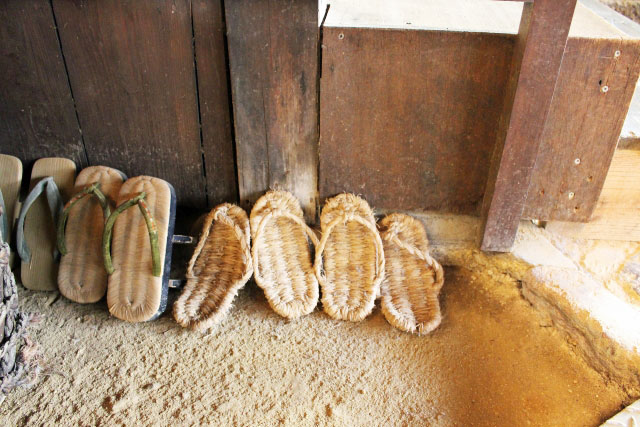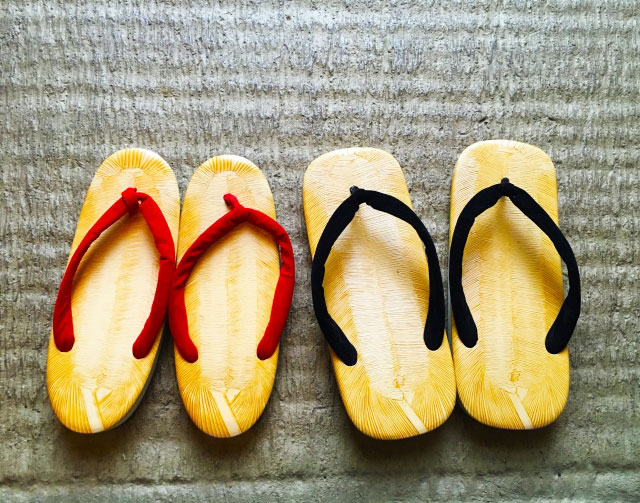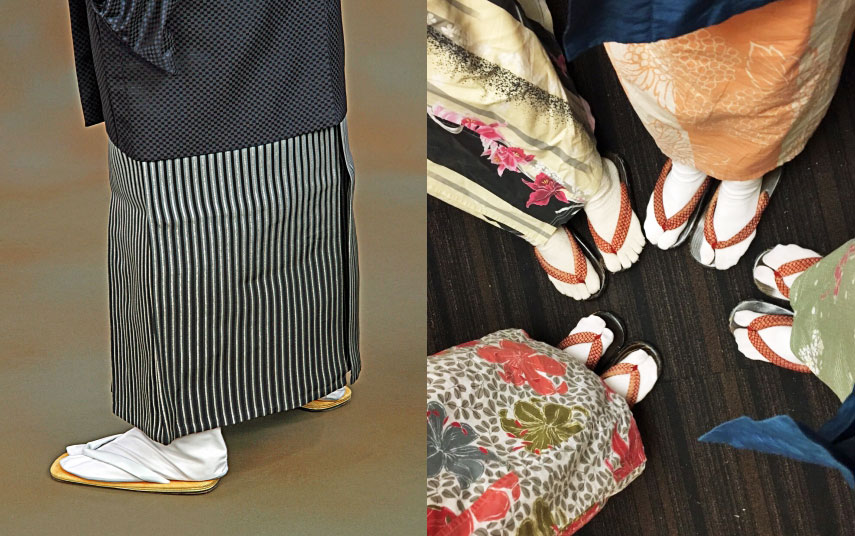日本の履物の歴史。草鞋(わらじ)、雪駄(せった)、下駄(げた)、足袋(たび)など、西洋靴が広まる以前の日本人の足元(靴)について。
History of Japanese footwear. About the footwear of Japanese people before Western shoes became widespread, such as 草鞋(straw sandals), 雪駄(setta), 下駄(geta), and 足袋(tabi).

「日本固有の靴(沓)」と言ってもよい、日本の伝統的な履物を紹介したいと思います。
西洋靴など欧米式の靴が一般的になった現代では、あまり履かなくなりましたが、どれも靴が広まる前までは、一般的に履かれていた履物です。しかし現代でも、着物(きもの)や甚平(じんべい)、浴衣(ゆかた)を着るときや、お祭りで御神輿を担ぐ際には多く履かれています。
また、どれも多湿の日本の気候に適した履物なので、現代風にアレンジした商品なども最近ではよく売られています。
「Shoes unique to Japan」Introducing traditional Japanese footwear.
Today in Japan, where dress shoes were introduced from Europe, they are no longer worn regularly.
However, even today, they are often worn when wearing a 着物(kimono), 甚平(jinbei), or 浴衣(yukata), or at Japanese festivals.
In addition, all of these footwear are suitable for Japan’s humid climate, so modern versions of these footwear have become popular recently.
▼草鞋(わらじ/Waraji)
▼藁靴・藁沓(わらぐつ/Waragutsu)・深靴(ふかぐつ/Fukagutsu)
▼草履(ぞうり/Zouri)
▼雪駄(せった/Setta)
▼下駄(げた/Geta)
▼足袋(たび/Tabi)
▼「文(もん/Mon)」日本固有のサイズ
▼まとめ
▼関連ページ(Related pages)
(説明文:靴のパラダイス店長 大嶋信之/explanation:Nobuyuki Oshima)
草鞋(わらじ/Waraji)
わらじは稲の藁で作られたサンダルのような履物です。
Waraji are sandal-like footwear made from rice straw.

草鞋(わらじ)は、稲藁で作られる日本古来からの伝統的履物のひとつで、奈良時代に誕生したと言われる。
長い緒によって、かかと、つま先、足首を結び、足を固定する。
舗装されていない道では、砂利が藁の隙間に入り底面の耐摩耗性を維持する。舗装されたアスファルト道では、耐久性が持たず不向きとされる。
Waraji(Footwear made of rice straw)is one of the traditional footwear from Ancient Japan.
It is said that it began to be made in the Nara period.
A long cord ties the heel, toe, and ankle to secure the foot.
On unpaved roads, gravel fills the gaps between the straw and maintains the wear resistance of the bottom surface. It is not durable and is not suitable for paved asphalt roads.

草鞋を編む職人。
昔は、草履などの稲藁を材料にした衣服等を生産することのが、人々の貴重な収入源でもあった。
A craftsman who knits straw to make Waraji.
In the past, the production of sandals and other clothing using rice straw was an important source of income for the Japanese people.

東京都台東区浅草にある、浅草寺(せんそうじ)の宝蔵門(ほうぞうもん/仁王門)裏手に掲げられている、大草鞋(おおわらじ)。
この大わらじは、山形県村山市奉賛会より10年に一度奉納されており、昭和16年に始まり平成30年で8代目となる。藁2500kgを使い、延べ人員800人により、約1ヶ月かけて作られ、全長4.5m、幅1.5m、重さ500kgもの大きさがあるという。宝蔵門(仁王門)の正面左右には二体の仁王像(左に呵形像、右に吽形像)が奉安され、門裏手の左右に対で大わらじが掲げられている。
草鞋は、仁王様(におうさま)の履物とされ、仁王様が脱いで掛けてあるという意味であるらしい。よって、この大きさは浅草寺宝蔵門の仁王様の力を表し、「このような大きなわらじを履くものがこの寺を守っているのか」と驚いて魔が去っていくと言われている。魔除けと健脚を願って大わらじに触れていく参拝客も多い。
The Big waraji(大草鞋/Ohwaraji)are hung behind the Houzoumon (Nioumon) Gate of Sensoji Temple in Asakusa, Taito-ku, Tokyo.
This large waraji is dedicated once every 10 years by the Murayama City Hosankai in Yamagata Prefecture, and began in 1944 and will be in its 8th generation in 2018.
This waraji uses 2,500 kg of straw and takes a total of 800 craftsmen about a month to make.
Waraji is said to be the footwear of the Nio-sama who protects the temple, and it is said that evil spirits leave the temple in surprise, thinking, “A person wearing such a large waraji protects this temple.”
藁靴・藁沓(わらぐつ/Waragutsu)・深靴(ふかぐつ/Fukagutsu)

草鞋同様、稲藁でつくった靴。
昔の日本人は、米作りを終えた冬に、藁を使って生活に欠かせない衣服を作った。
写真は、深靴(ふかぐつ)と呼ばれる、積雪時のための履物で、雪靴(ゆきぐつ)とも呼ばれる。
Straw boots called 「深靴 fukagutsu(deep shoes)」or「雪靴 yukigutsu(shoes for snow)」.
In the past, Japanese people used straw to make clothes that were essential to their lives in the winter after they had finished growing rice.
The photo shows footwear for when it snows, called「深靴 fukagutsu (deep shoes)」, also called「雪靴 yukigutsu (snow shoes)」.
草履(ぞうり/Zouri)

草履(ぞうり)は、草鞋に似ているが、緒の形が異なり、「鼻緒(はなお)」と呼ばれる、現代のビーチサンダルのような形状をしたつま先だけの緒がついた履物で、平安時代中期に誕生したと言われています。
親指(母趾)と第二趾のあいだに、鼻緒を挟み足を固定して履く。
藁でつくられた草履を「藁草履(わらぞうり)」と言い、かかとの無い草履を「足半(あしなか・あしたか)」と言います。
明治、大正時代には板やタイヤ、ゴムを付けた草履が発明され、明治以降、洋靴が普及する昭和初期まで日本で広く履かれていました。
Zori sandals are similar to grass sandals, but the shape of the laces is different.The laces are attached only to the toes, called「鼻緒(hanao)」, and are shaped like modern-day flip-flops. It is said to have been created in the middle of the Heian period.
They are worn by placing a thong between the big toe and second toe to secure the foot.
Sandals made from straw are called 「藁草履(wara zori)」,and zori without heels are called 「足半(ashinaka)」.
During the Meiji and Taisho periods, sandals with boards, tires, and rubber were invented, and they were widely worn in Japan from the Meiji period until the early Showa period, when Western shoes became popular.
雪駄(せった/Setta)

雪駄(せった)は草履の一種で、竹皮草履の裏面に皮を貼って防水機能を与え、皮底の踵部分に尻鉄がつけて耐久性をもたせた、江戸時代からの伝統的な履物です。
現代でも、男性が着物を着るときは雪駄が多く用いられる。
子供のうちから雪駄を履くと、足が広がって安定し外反母趾になりにくく、足が蒸れず水虫(足白癬)などにもなりにくい。多湿の日本に適した履物。
Setta is a type of zori sandals, a traditional sandal from the Edo period that is made from bamboo leather with leather pasted on the back to make it waterproof, and a heel of the leather sole attached to the heel for durability footwear.
Even today, when men wear kimono, they often use setta.
Wearing setta from childhood allows the feet to spread out and stabilize, making it less likely that bunions will occur, and the feet will not get stuffy and will be less prone to developing athlete’s foot (tinea pedis). Footwear suitable for humid Japan.
下駄(げた/Geta)

下駄(げた)も日本古来からの伝統的履物のひとつ。
桐などの木や、竹から土台がつくられ、鼻緒に指を通して足を固定する。
平安時代、奈良時代には、地方の豪族が権威の象徴として履き、江戸時代までは裕福な人がおしゃれで履いていたとされています。明治、大正時代には機械生産されるようになり、大衆に普及しました。
ぬかるんだ道でも足が沈まず、足が汚れにくいことから、雨の多い日本では重宝されました。
Geta (geta) is also one of Japan’s traditional footwear.
The base is made of wood such as paulownia or bamboo, and the feet are secured by passing the fingers through the thong.
It is said that during the Heian and Nara periods, local powerful families wore them as a symbol of authority, and until the Edo period, wealthy people wore them for fashion.
In the Meiji and Taisho eras, it began to be produced by machines and became popular among the masses.
They were useful in Japan, where there is a lot of rain, because they didn’t sink and didn’t get your feet dirty even on muddy roads.
足袋(たび/Tabi)

足袋(たび)は、木綿の布で作られた足に履く下着のようなもので、小鉤(こはぜ)と呼ばれる特有の留め具で足を固定する。草履、雪駄、下駄を履く際に用いる。
熊皮、鹿皮、猿皮などでつくられた皮足袋もある。
足袋の起源は、奈良時代にあった「襪(したうず)」とよばれる布製の親指が分かれていない履物だとされ、当時外履き用に皮でつくった「単皮(タンピ)」が「タビ」の語源と言われている。
Tabi is a type of underwear made of cotton cloth that is worn on the feet, and is secured with a unique clasp called「小鉤(kohaze)」. Used when wearing zori sandals, setta, and geta.
There are also leather tabi socks made from bearskin, deerskin, monkeyskin, etc.
「Tabi」 is said to have its origins in Nara period cloth footwear with an undivided thumb called 「襪(shitauzu)」, and leather footwear for going out called 「単皮(tanpi)」.

現代でも男性も女性も、着物(きもの)に合わせる履物として、「足袋(たび)」+「草履(ぞうり)」が一般的です。
Even today, 「tabi」 and 「zori」are common footwear worn with kimono for both men and women.

現代では、ゴム底がついた「地下足袋(じかたび)」という外履き用の足袋が多く売られれている。
作業労働用や、祭に履く「祭足袋(まつりたび)」などがある。
Nowadays, many tabi socks with rubber soles for outdoor wear called ”地下足袋(jikatabi)” are sold.
There are ”祭足袋(matsuri tabi)”, which are worn for labor and festivals.

埼玉県行田市にある「足袋とくらしの博物館」。(写真:shoepara.jp)
実際の足袋工場跡地の設備をそのまま残して作られた、足袋作りを体験できる博物館。土日のみ開館している。
埼玉県行田市は、かつて全国シェア80%を誇った時期もあったほど足袋の名産地として知られている。
埼玉県は現在でも、徳島県に次いで第2位の足袋生産地だ。
『The Tabi and Lifestyle Museum』is located in Gyoda City, Saitama Prefecture.(Photo: shoepara.jp)
A museum where you can experience tabi making, built on the site of an actual tabi factory. It is open only on Saturdays and Sundays.
Gyoda City, Saitama Prefecture, is known as a famous producer of tabi socks, which at one time boasted an 80% share of the national market.
Saitama Prefecture is still the second largest producer of tabi socks after Tokushima Prefecture.
文(もん/Mon)
文(もん)は、江戸時代に使われた、日本固有の足のサイズを表す単位です。
一文=一文銭の大きさだとされ、一文=約2.4cmです。
センチが使われる前まで、日本では使われていました。
「文(MON)」 is a unique Japanese unit of foot size used during the Edo period.
A MON is said to be the size of a coin, and one MON is approximately 2.4cm.
It was used in Japan before the centimeter came into use.
【現代のサイズ(cm)との換算表/Conversion table with modern size (cm)】
センチ(cm)/文数(MON)
21.5cm/九文(9 MON)
22.0cm/九文三分(9 and 1/3 MON)
22.5cm/九文半(9.5 MON)
23.0cm/九文七分(9 and 7/10 MON)
23.5cm/九文八分(9 and 8/10 MON)
24.0cm/十文(10 MON)
24.5cm/十文三分(10 and 1/3 MON)
25.0cm/十文半(10.5 MON)
25.5cm/十文七分(10 and 7/10 MON)
26.0cm/十一文(11 MON)
26.5cm/十一文三分(11 and 1/3 MON)
27.0cm/十一文半(11.5 MON)
28.0cm/十二文(12 MON)
29.0cm/十二文半(12.5 MON)
30.0cm/十三文(13 MON)
まとめ(summary)
欧米式の靴(くつ)が普及するまで、日本では以上のような履物が履かれていました。形状もかかとのない履物が主流であったため、日本人はつま先に重心を置いた歩行をしていたそうです。また、外で足が汚れることが多かったため、家の門口で足を洗う習慣もあったそうですが、足を覆う靴が広まるとそんな習慣もなくなっていきました。
筆者が感じたのは、多湿の気候の多い日本において、理にかなった素材・機能がそこにあったのだと、改めて関心させられました。現代のような舗装された道には不向きかもしれませんが、それにも材料の改良などで対応し、デザインや素材も現代風にアレンジして、その長所を兼ね備えた靴が復刻(リバイブ)できたらいいなと思いました。
Until Western-style shoes became popular, the above type of footwear was worn in Japan.
Because footwear without heels was the mainstream, Japanese people apparently walked with their center of gravity on their toes.Also, because their feet often got dirty outside, it was customary to wash them at the door of the house, but this custom disappeared as shoes that covered the feet became popular.
What I felt was that there was a material and function that made sense in Japan, which has a humid climate, and I was once again interested in it.
It might not be suitable for modern paved roads, but I thought it would be nice to bring back a shoe that combines these benefits with improved materials and modernized designs and materials.
関連ページ(Related pages)

Japanese words used when shopping at Japanese shoe stores(日本の靴屋で買い物をする際に使われる日本語)
We will explain the English translations of Japanese words used when shopping at Japanese shoe stores.
Please use this information when buying shoes in Japan.
(日本の靴屋で買い物をするときに使われる日本語の英語訳を説明します。日本で靴を買う際に、お役立てください。)

The size of Japanese leathershoes and the size of nationalbrand sneakers are different.
日本の革靴サイズ(JIS)とナショナルブランドのスニーカーサイズの違いについて。(英文)
